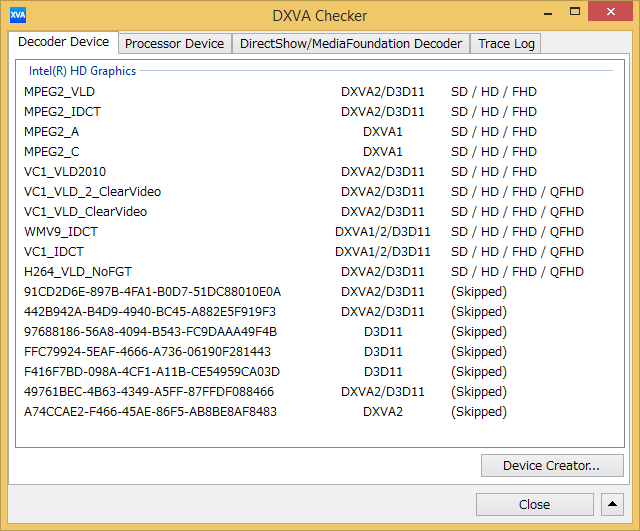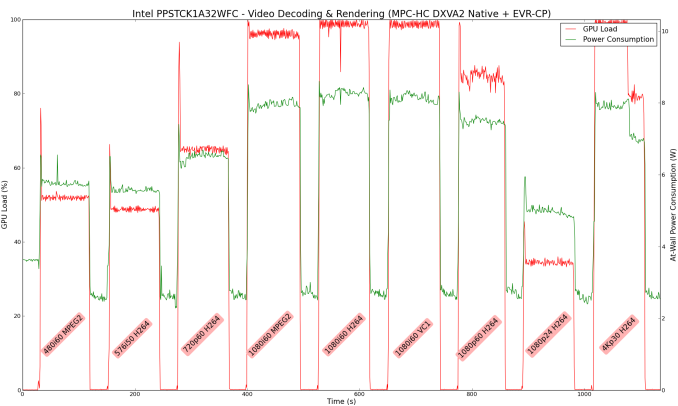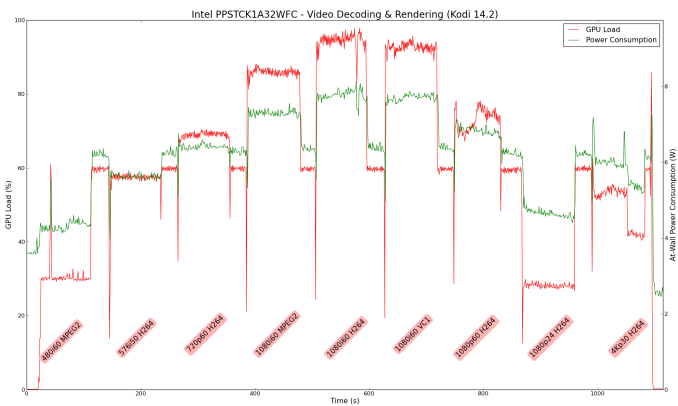Intel PPSTCK1A32WFC Bay Trail-T Compute Stick Review
by Ganesh T S on April 22, 2015 11:00 AM EST- Posted in
- Systems
- Intel
- Bay Trail
- HDMI Stick
HTPC Credentials
Usage of the Compute Stick as an entertainment platform is promoted by Intel as one of the use-cases. It is a bit surprising (given the form factor) that the Compute Stick has a fan. Subjectively, I was not comfortable with the acoustics in a 'office scenario' with the Compute Stick at the base of the monitor (connected via the HDMI extender cable) and myself seated around 70 cms. from it. The small diameter of the fan makes for a whining high-pitched noise, and it is compounded by the fact that it starts and stops depending on the SoC load.
Objectively speaking, Intel provided an acoustics rating of 28 dB at 1m distance for the noisiest mode. If the Compute Stick were to be hidden behind the TV, it is unlikely that users can hear such low noise at typical television viewing distances. It is not ideal, but Intel indicated that the performance of the device needs proper thermals. In order to to balance the very small size along with overall cost and performance, they went with a small fan as the optimal thermal solution. Now that we have got the acoustics out of the way, let us move on to the other HTPC aspects.
Refresh Rate Accurancy
Starting with Haswell, Intel, AMD and NVIDIA have been on par with respect to display refresh rate accuracy. The most important refresh rate for videophiles is obviously 23.976 Hz (the 23 Hz setting). The Intel PPSTCK1A32WFC has no trouble with refreshing the display appropriately in this setting, but it is not as accurate as Haswell or Broadwell or even other Bay Trail-based systems (refreshing at 23.973 Hz instead of 23.976 Hz).
The gallery below presents some of the other refresh rates that we tested out. The first statistic in madVR's OSD indicates the display refresh rate.
Network Streaming Efficiency
Evaluation of OTT playback efficiency was done by playing back our standard YouTube test stream and five minutes from our standard Netflix test title. Using HTML5, the YouTube stream plays back a 720p encoding. Since YouTube now defaults to HTML5 for video playback, we have stopped evaluating Adobe Flash acceleration. Note that only NVIDIA exposes GPU and VPU loads separately. Both Intel and AMD bundle the decoder load along with the GPU load. The following two graphs show the power consumption at the wall for playback of the HTML5 stream in Mozilla Firefox (v 37.0.1).

GPU load was around 51.56% for the YouTube HTML5 stream and 4.53% for the steady state 6 Mbps Netflix streaming case. Mozilla Firefox is terribly inefficient in terms of power for YouTube playback. The same test stream, when played back in Internet Explorer, consumed only 3.55 W on an average and had a GPU load of 9.1% for the same H.264 stream.
Netflix streaming evaluation was done using the Windows 8.1 Netflix app. Manual stream selection is available (Ctrl-Alt-Shift-S) and debug information / statistics can also be viewed (Ctrl-Alt-Shift-D). Statistics collected for the YouTube streaming experiment were also collected here. The power efficiency of the Compute Stick platform comes to the fore here.

Decoding and Rendering Benchmarks
The form factor of the Compute Stick and the internal components make it clear that consumers are not going to play back videos using the madVR renderer. Instead, it is highly likely that Kodi will be used as the interface for media playback. We evaluated performance under MPC-HC + EVR-CP and Kodi 14.2 for our test suite. Prior to those results, let us take a look at the codecs that are hardware-accelerated by the Bay Trail-T SoC.
As expected, we have acceleration for MPEG-2, VC1, WMV9 and H.264. HEVC is not necessary for such a platform at this point in time.
In our earlier reviews, we focused on presenting the GPU loading and power consumption at the wall in a table (with problematic streams in bold). Starting with the Broadwell NUC review, we decided to represent the GPU load and power consumption in a graph with dual Y-axes. Nine different test streams of 90 seconds each were played back with a gap of 30 seconds between each of them. The characteristics of each stream are annotated at the bottom of the graph. Note that the GPU usage is graphed in red and needs to be considered against the left axis, while the at-wall power consumption is graphed in green and needs to be considered against the right axis.
Frame drops are evident whenever the GPU load consistently stays above the 85 - 90% mark. In addition to tracking that aspect in the graphs below, we also get an idea of the system's power efficiency for decode and playback of some common codecs.
The above graph suggests that the Compute Stick is likely to drop frames when deinterlacing of high frame rate content is required. It is possible that EVR, the native renderer, will perform better than EVR-CP.
Kodi doesn't deinterlace content by default - so, the GPU load goes unreasonably high only for the 1080i60 stream. Another aspect to observe with Kodi is that 'idling' at the XBMC interface consumes around 60% of the GPU resources and the power penalty is around 6 W. Depending on the codec and frame rate, the GPU load and power consumption might be lower or higher than the 'idle' state. For example, 480i60 and 1080p24 videos play back within the 5 W power envelop.
Note on HD Audio Bitstreaming
As of April 2015, the Intel graphics drivers for Bay Trail-T (32-bit) have support only for bitstreaming of DTS, Dolby Digital and Dolby Digital Plus. This means that Netflix and other similar OTT sites are in the clear. However, users hoping to take advantage of lossless HD audio in Blu-ray backups are going to be disappointed. In any case, streaming of Blu-rays over a 802.11n Wi-Fi network will result in a bad user experience. So, it is possible that the absence of HD audio bitstreaming will not bother too many consumers.



















103 Comments
View All Comments
Refuge - Wednesday, April 22, 2015 - link
There are other reviews, that have not ran into any such problems installing the updates to the stick.So no, that isn't the case.
ganeshts - Wednesday, April 22, 2015 - link
Did they even mention whether they tried to do the update ? In any case, after the 'Refresh', I installed 1.3+ GB of updates all over again, and the second time went without a hitch. I think it depends on a lot of factors - eMMC behavior etc. , but, in general, it would be preferable to have plenty of free space on the primary drive for OSes such as Windows.BrokenCrayons - Wednesday, April 22, 2015 - link
Great review as always, but the Compute Stick isn't quite enough and it really doesn't have much to do with the CPU, but storage. The 32GB of storage problem has really been the biggest turn off of these kinds of small computing platforms. It'd work fine for most Linux distros, but Windows needs a good 16-32GB more, I think, before the device becomes flexible enough to use for things beyond very basic content consumption. I'd had hopes about Cherry Trail systems sticking around the same price point while offering a generational improvement in storage capacity, but with Intel's pricing, I have doubts that there'll be a sub-$150 device that ships with 2GB of RAM and 64GB solid state storage in the near term.Mr Perfect - Wednesday, April 22, 2015 - link
PPSTCK1A32WFC? Uhm, how much do you want to bet that people start calling it the peepee stick. I wonder if this was the marketing guys having a laugh, or if they honestly didn't think the name was questionable. It should be standard practice to run marketing material past a fifth-grader to see if they laugh(or me, apparently).BMNify - Wednesday, April 22, 2015 - link
Intel Compute Stick is the name of the product, looks pretty simple and self-explanatory to me, the detailed product code number is not marketed by anyone.biofishfreak - Wednesday, April 22, 2015 - link
Ganesh, do you know/ can you test if you can add this Compute Stick to a Windows domain?ganeshts - Wednesday, April 22, 2015 - link
It is running Win 8.1 with Bing - not Pro or Enterprise - as far as I can see, it is not possible to add this to a Windows domain.Kinemaxx - Wednesday, April 22, 2015 - link
So, the question that runs through my mind in every single one of these types of reviews, yet never seems to be given consideration: How well can these units play back Hi10p encoded h264 video? (either 720p or 1080p) Hi10p can't be GPU accelerated, so can they play video like that back at all, or will it be like watching a slideshow (as was the case on a friend's very early netbook)? I know Kodi is capable of playing back 10-bit video, so since they used Kodi in the test, it should certainly be testable.zeo - Monday, April 27, 2015 - link
Bay Trail is a good step up from the older Netbook ATOMs... 2-3x the performance... Chippy, from UMPCPortal, has a video demonstrating Hi10p playback. X.264 10-bit encoded file on a Bay Trail based Intel NUC... if you want to see how well Bay Trail handles such videos...Basically, Bay Trail's can usually handle Hi10p encoded videos, though, they can struggle a bit with 1080p Hi10P w/ FLAC audio... but it's watchable in most cases, depending on what you're watching and whether anything else is going on that also adds CPU load...
However, the SoC in this PC stick is on the lower end of the scale... So it may struggle a bit more and may require lowering expectations to 720P for smooth playback...
Twingo - Wednesday, April 22, 2015 - link
Price seems steep. You can get a tablet like the HP Stream 7 for < 100 dollars. Not sure why this would cost > 50% more when there is no battery or screen to drive up cost. If this were priced in the 70-80 dollar range that would make much more sense.